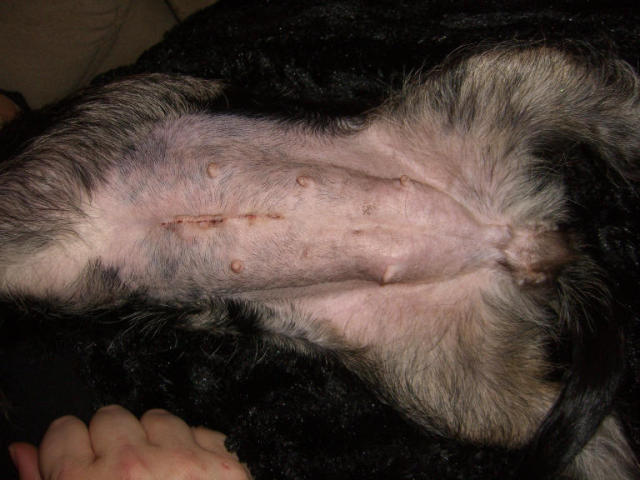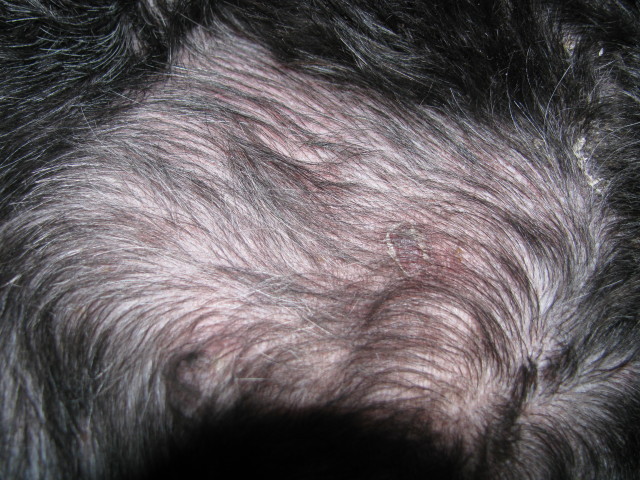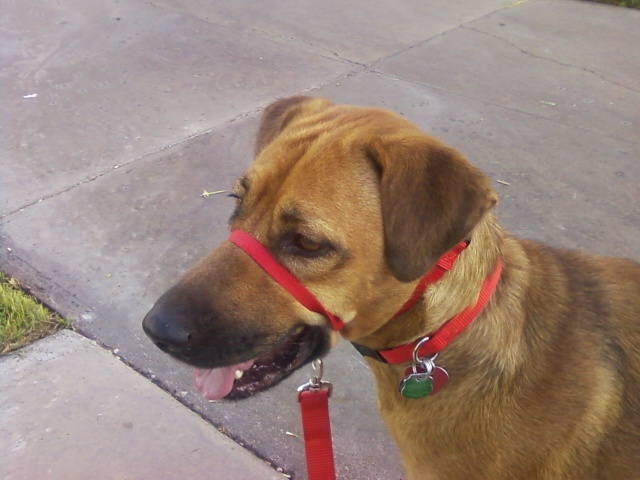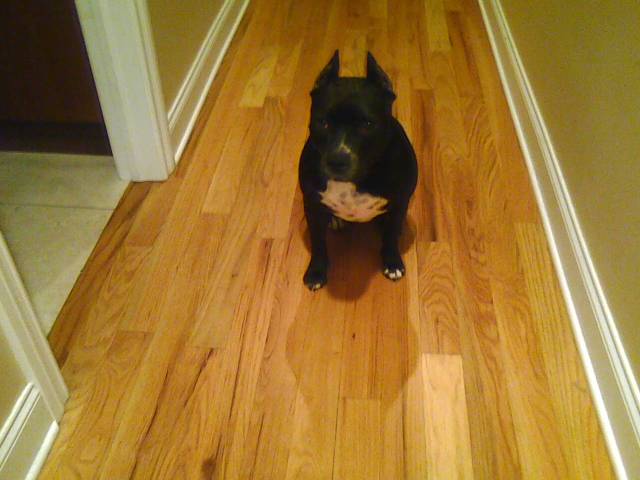QuestionKristen,
Thanks for the quick reply!
He is about 10 lbs. He wears the harness because when we are out for walks he gets scared of people and one time he pulled out of his collar and ran across a really busy street in rush hour traffic! I about had a heart attack. Since then we've used the harness and had a terrible time. I will try the cookie trick first then resort to leaving the harness on him for a while. It sounds correct that he is trying to play a game with me. I don't think he perceives me as "boss". I've tried my hardest to play momma pup tough love with him but he thinks everything is a game. Every discipline tactic we have tried does not work with him. We've tried a squirt bottle, rolled up news paper, loud irritating noises, you name it, and he just keeps being naughty. Recently I have been turning him on his back and holding him there. The war of the wills kicks in and he fights and fights! One time is lasted 15 minutes before he settled down even a little. As for walks, he does walk in front of me. I've tried to use a different type of collar (the one where you loop it right behind their ears) but for some reason the shape of his head/body doesn't really take to that kind of collar. Also, it doesn't work w/ the harness. When we walk he is always in front of me. If I try to keep him at my side he will just choke himself.
-------------------------
Followup To
Question -
Hello Kristen,
I have a problem w/ my 8 mo. old Yorkie/Maltese mix. He loves going on walks with me and I walk him almost everyday. My problem comes when I try to put his harness on him. He bites me and the harness and he tries to wrestle it away from me. I know he loves going for walks but he can't stand to have the harness put on him. He will not sit still for me. I've trained him to sit on command but he will not do it when he sees the harness in my hand. I've tried giving him cookies while I put the harness on but that doesn't work either. I've watched the Dog Whisperer TV show when they had a dog w/ a similar problem. The trainer on that show just put the harness out in the air and the dog walked right into it! I tried that once (just for laughs basically) and Foster lunged at it and shook it. Any guidance would be GREATLY appreciated!
Answer -
How funny! My boss' name is Foster!
Morgan, it sounds like he views harness-putting-on time as a game. Either that or he fears it. It's hard to tell without actually seeing his behavior in person. Have you tried holding the harness out in the air like what you saw on TV, but luring him into it with a treat held between your fingers, and not giving him the treat until he was essentially in the harness? What about just leaving the harness on him; putting it on him in the morning or when you get home from work and leaving it on him until bedtime)? That may work because he may view the harness as a bad thing since it restricts his movements when you put it on him. Letting him wear it without taking him for a walk might change his perception of it.
How big is Foster? Have you considered using just a flat collar instead of the harness for taking him for walks? Providing it is wide enough, you shouldn't have to really worry about doing any damage to his neck, unless you make a habit of jerking and pulling on the leash. Does he pull against the leash when you walk? If so, then I would recommend teaching him not to. If you need help with that, let me know. It's not as difficult as you may think.
Let me know if there's anything else you need!
Kristen
AnswerAhhhh. I can see why you would want to use a harness if he can easily back out of just a collar. There IS a collar on the market made especially for dogs that can back out of a regular collar - it's called a "martingale" or greyhound collar. At first glance, it looks like any other flat collar, but upon closer inspection, you can see that when tension is applied to the leash, the collar actually tightens around the dog's neck so that he cannot pull it off over his head. It has what is called a 'limited slip' (like a prong collar) and can only tighten so far, and this is what keeps the dog from being able to pull out of it. Just something else to think about, if you still have problems with the harness after a week or so. Here are a link that shows you what a martingale collar looks like, though it is fitted a little loose:
http://www.petsmart.com/global/product_detail.jsp?cm_ven=ovt&cm_pla=unknown&cm_i
You don't actually want *quite* that much 'play' in the loop that the leash is attached to, but this does at least show you what the collar looks like and gives you an idea of how it works. :^)
I still think just letting him wear the harness at all times (except for bedtime and when you are not home) will help him to get over making a big deal about it. Just make sure it isn't too tight or too loose, because if it's too tight then it will obviously be uncomfortable, and if it's too loose it could rub him and cause irritation.
Whichever tool you decide you use with Foster, you want to get him out of the habit of pulling you along on your walks as well, so here is a suggestion on how to do that:
For the first few days to a week, plan on not getting anywhere when you take him out for a walk. Don't start out thinking you're going to walk around the block; it's likely you won't even get out of your yard.
Clip his leash (it should be a cloth or leather leash; no longer than 6 feet - NOT a retractable leash) to his harness or collar, pick him up, and go outside (you will want to teach him to allow you to walk through the door ahead of him at some point, but for now, just carry him out the door). I don't know whether you live in a house, condo, apartment, or what, but if you live in a house, go off the porch if you have one, and then set him down. If you live in an apartment complex or condo, then carry him to the area where you are allowed to walk him before setting him down.
When you set him down, praise him, because at that point, the leash will be slack. Say, "Good boy, Foster! Good boy!" in a happy tone of voice! Then, start forward as normal. You may only get one or two steps; that's normal. *Just before* he reaches the end of the leash and starts to pull. Stop dead in your tracks, and do not say a word. Foster will hit the end of the leash and probably start trying to pull. Do not move - stand stock still. At some point, Foster will give up, stop trying to pull, and turn and look at you. As soon as he lets up pulling and turns towards you, praise him warmly! This *should* make him actually move towards you, and when he does that, you should start forward again, praising him because the leash is slack. Repeat, repeat, repeat - for up to 15 minutes or so. The point is that he should start to realize that when he pulls on the leash, he doesn't get to go anywhere, but when he doesn't pull, he does get to go. Eventually (and it can take a few days to a few weeks), he should be happily walking along without pulling on the leash. Walks then become a positive experience for both you AND him. :^) Another take on the same principle is to make an abrupt right or left turn *just before* he reaches the end of the leash, and begin walking off in THAT direction. You may end up pulling him along for a few steps, but trust me, he'll catch right up, and whenever the leash is slack, you should be praising him! "Good boy! Yes! Good! Good boy! Yay!" etc. You may feel silly, but praise is very important, and you won't have to keep doing it forEVER. This technique will teach him to not only keep slack in the leash, but to keep an eye on you as well, so he knows that when you turn, he needs to follow.
And one last thing I think you will benefit from is putting Foster on the "Nothing in Life is Free (NILIF)" Program. Basically, this is a simple, safe, and effective way of making yourself the alpha dog (leader of the pack) without resorting to force or getting physical with your dog. It simply requires that your dog 'earn' everything from you. For example, if he wants to be petted (or if you just want to pet him), you must ask him to follow a command before he gets petted. The same goes for toys, food, and treats. If he is allowed up on the furniture, you need to stop allowing it unless you command him to get up there, and likewise, he needs to get off the furniture when told, without protesting. If he comes over to you with a toy and wants to play, you ignore him until he loses interest. Then, you get the toy and take it to him and initiate play. When you want to stop, playtime is over, and you should ALWAYS be the one to 'win' the toy. After winning the toy, get up and walk away with it. Keep it with you or put it away for a while. Here are some links with more information on the NILIF program:
http://k9deb.com/nilif.htm
http://www.greyhoundlist.org/nothing_is_free.htm
http://www.k9force.net/nilif.html
www.ddfl.org/behavior/nilif.htm
I would recommend that you immediatly stop forcing him onto his back and holding him there. This is what many trainers call "The Alpha Roll," and while it used to be favored by many trainers, more and more are discouraging its use. The common thinking behind the alpha roll used to be that in the wild, the leader of the pack would force the more submissive dogs onto their backs and hold them there to enforce their alpha position. However, more recent studies indicate that the alpha isn't actually forcing the subordinate dog down; the subordinate dog is the one going to the ground and showing his belly to the alpha as a display of submission and respect. The alpha does not hold the subordinate dog down at all. In fact, the only time a wild dog will force another one to the ground and onto its back is when it plans on killing the other dog! You don't want Foster to think you're going to kill him, so stop doing the alpha roll technique with him ASAP. If you know anyone else that is still doing it with their dogs, please pass what I've just told you on to them. Not only is the alpha roll extremely stressful for your dog, because he thinks you're going to hurt him, but it can really damage the bond that you and your dog share, and it can also result in you getting bitten.
Kristen

 Dachshund spay - swollen mammaries
Question
Lilly
Hi Patti,
We took our 10 month old mini
Dachshund spay - swollen mammaries
Question
Lilly
Hi Patti,
We took our 10 month old mini
 Dog fur is flaking off, scabbing, itching like crazy
Question
zacks tummy
Hi,
We have a four-year-old cockap
Dog fur is flaking off, scabbing, itching like crazy
Question
zacks tummy
Hi,
We have a four-year-old cockap
 Bedwetting and poop eating
QuestionQUESTION: We have a 12 week old beagle cross wh
Bedwetting and poop eating
QuestionQUESTION: We have a 12 week old beagle cross wh
 My dog Kiya
Question
Kiya
My new dog Kiya is a 2 yr old German Shep
My dog Kiya
Question
Kiya
My new dog Kiya is a 2 yr old German Shep
 AmStaff Terrier
QuestionMy dog
QUESTION: I have a 2 1/2 year old
AmStaff Terrier
QuestionMy dog
QUESTION: I have a 2 1/2 year old